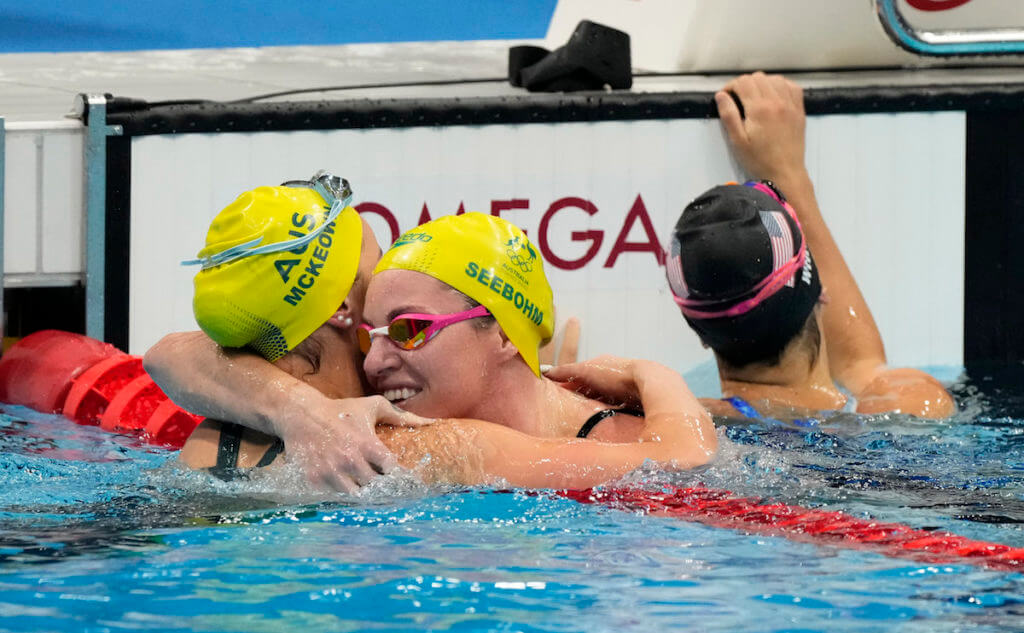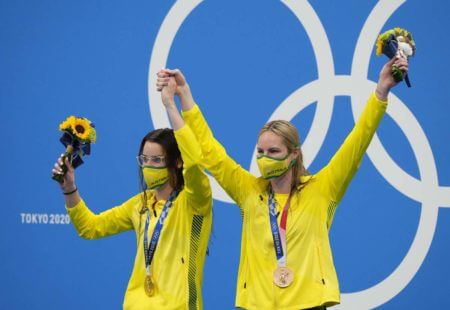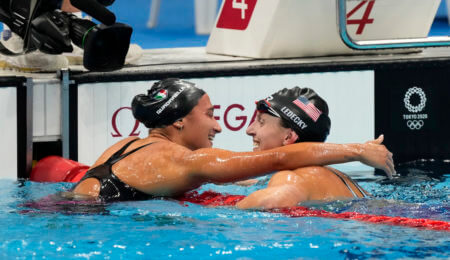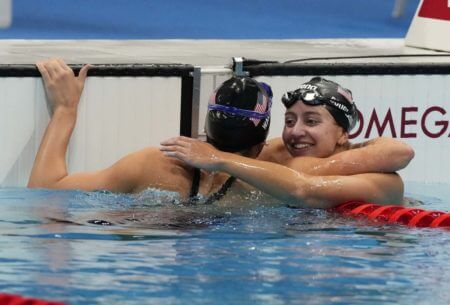The Top Under-the-Radar Women’s Performances from the Tokyo Olympics

Editorial content for the 2021 Tokyo Olympic Games coverage is sponsored by GMX7.
See full event coverage. Follow GMX7 on Instagram at @GMX7training #gmx7

The Top Under-the-Radar Women’s Performances from the Tokyo Olympics
The Tokyo Olympics swimming competition produced many stars, some old and some new, some expected and some surprising. On the women’s side, you think of Emma McKeon’s seven-medal performance, Ariarne Titmus‘ sensational victory over Katie Ledecky in the 400 freestyle, Ledecky winning the inaugural gold medal in the 1500 free and capturing her third straight title in the 800 free, Yui Ohashi becoming Japan’s star of the swimming portion of the Games with her two IM wins, Kaylee McKeown affirming her status as the world’s premier female backstroker and Tatjana Schoenmaker’s emergence that culminated with a world record in the women’s 200 breaststroke.
But in this space, we will focus on a handful of performances that did not get so much attention, maybe a swimmer who took silver or bronze or even fourth place. This is by no means an exhaustive list of impressive swimmers from the Olympics but a few that deserve another nod in case their exploits from a long week of swimming went unnoticed.
1. Emily Seebohm Returns to Olympic Podium in 200 Backstroke
McKeown’s gold medals in the 100 and 200 back were the first ever for Australia in women’s backstroke, an honor Emily Seebohm came very close to accomplishing in 2012. In her second Olympics, Seebohm set an Olympic record of 58.23 in the 100 back prelims but could not match that time through the next two rounds, and American Missy Franklin would edge out Seebohm for gold in the final, although Seebohm would collect her first individual Olympic medal with a silver. Four years later, Seebohm arrived at the Rio Olympics as the reigning world champion in both backstroke events and as the heavy gold-medal favorite in the 100 back, having almost broken the world record multiple times over the previous year, but she ended up a surprising seventh in the 100 back final. She ended up 12th in the 200 back.

Kaylee McKeown and Emily Seebohm on the medal podium after the 200 backstroke at the Tokyo Olympics — Photo Courtesy: Rob Schumacher/USA Today Sports
Seebohm would rebound in 2017 to earn bronze in the 100 back and an impressive gold in the 200 back at the World Championships, but by 2019, she was struggling again, and she failed to qualify for the World Championships as McKeown and Minna Atherton claimed Australia’s two slots in both backstroke events. And that’s why it meant so much for Seebohm to return to the Olympic team this year — for her fourth Games — and to earn the second individual Olympic medal of her career. Seebohm, now 29, finished fifth in the 100 back in 58.45 (matching the gold-medal winning time from 2016) and then earned a surprising bronze in the 200 back, her final time of 2:06.21 beating American Rhyan White for the last spot on the podium by two tenths.
To cap off the immensely satisfying moment, gold medalist McKeown invited Seebohm to the top step of the podium as “Advance Australia Fair” echoed through the Olympic Aquatic Centre.
“Pretty unbelievable. I didn’t think I would get this (medal) again,” Seebohm said. “I’m just so grateful because it’s so hard, getting on this team every year, and it’s something that I hold so special to my heart these days. I’ve had the time of my life here.”
2. After Disappointing 1500 Free, Simona Quadarella Rebounds with 800 Bronze
In 2019, Italy’s Simona Quadarella was the world champion in the 1500 freestyle, claiming the honor in the absence of an ill Katie Ledecky. Quadarella came close to winning the 800 free world title, too, as she and Ledecky battled for 750 meters before Ledecky managed one final surge on the last 50 to pull away and claim gold. After her 2019 success, many expected the 22-year-old Quadarella to be in the hunt for medals in the 1500 free in Tokyo, but after a strong start had her in second and third place for much of the race, Quadarella faded and finished fifth, more than 11 seconds out of the medal picture and more than 13 seconds slower than her world-title winning time from 2019.

Simona Quadarella (left) celebrates with Katie Ledecky after earning bronze in the 800 free at the Tokyo Olympics — Photo Courtesy: Rob Schumacher/USA Today Sports
Quadarella still had one more chance at capturing a medal in Tokyo, in the 800 free, so she pulled off one of the hardest feats in swimming: put a bad swim in the past and refocus for the next one. “I tried to delete the performance in the 1500, and the 800 was another chance for me,” Quadarella said. “I tried to reset my head. I wanted to get this medal.”
And indeed she did get that medal. Ledecky and Ariarne Titmus finishing first and second (in some order) was basically a foregone conclusion before the race, so Quadarella would have to take on swimmers like 15-year-old American Katie Grimes, 1500 free bronze medalist Sarah Kohler and Chinese star Wang Jianjiahe to try to earn a medal. Quadarella was fourth or worse for the first half of the race, but she moved ahead of Grimes on the ninth of 16 lengths and never surrerendered that advantage. Quadarella finished in 8:18.35, more than three seconds off her best time, but she had secured that elusive Olympic medal.
3. Teenagers From USA and UVA Rush the Podium in Individual Medley
The United States had been in a dry spell in the women’s IM events, with only one World Championships medal (Madisyn Cox’s 200 IM bronze in 2017) since the 2016 Olympics. That changed in a big way in Tokyo as a trio of teenagers along with veteran (but IM newcomer) Hali Flickinger swept all the podium spots behind gold medalist Yui Ohashi. And that happened in very impressive fashion.
In the 400 IM on day one in Tokyo, 19-year-old Emma Weyant was fourth at the halfway point and moved up to second on the breaststroke leg behind Ohashi. She still trailed by two seconds at the last turn, but she made up more than half of that deficit to put a scare into the Japanese gold medalist. Weyant claimed silver in 4:32.76, her time good enough to move her to 17th all-time in the event and fifth ever among Americans.

Alex Walsh (left) and Kate Douglass celebrate winning silver and bronze, respectively, in the 200 IM at the Tokyo Olympics — Photo Courtesy: Rob Schumacher/USA Today Sports
Three days later, two other 19-year-old Americans joined Ohashi on the podium in the 200 IM. Alex Walsh led the field after 150 meters by just seven hundredths over Ohashi, with Kate Douglass in close pursuit. On the last 50, Walsh faced the tall task of trying to hold off Ohashi while Douglass was surging ahead of everyone else in the race. At the finish, Ohashi barely got ahead of Walsh to win gold, 2:08.52 to 2:08.65, and Douglass took bronze in 2:09.04. In their first Olympic final, both women swam their lifetime best performances, with Walsh moving to 17th all-time (fourth among Americans) and Douglass to 23rd in history (eighth among Americans).
And all three of those Olympic medalist teenagers, Weyant, Walsh and Douglass, swim for the University of Virginia. Douglass is a rising junior, Walsh a rising sophomore and Weyant will begin her first year in Charlottesville after deferring in 2020-21 due to the COVID-19 pandemic. That trio represents the present and the bright future in the IM events for the United States.
“We’re doing really well, but I think it’s a huge learning opportunity for us. I am really excited for the rest of my career having this meet under my belt,” Walsh said. “I couldn’t be prouder of us. We’re making a statement, which I think is great.”
Douglass added, “It has been great watching my USA teammates medal (and) do amazing things, so it was a nice chance for us to do that together. It was awesome we were able to do that.”





How about Lily King rebounding from a disappointing 100 breast to become the second American and seventh woman ever under 2:20 in the 200 breast? It was a breakthrough swim for her at that distance, her first medal in a 200 at a worldwide competition.
Lily King is never “under the radar”…..
Funny, I would also say Seebohm is never under the radar either!